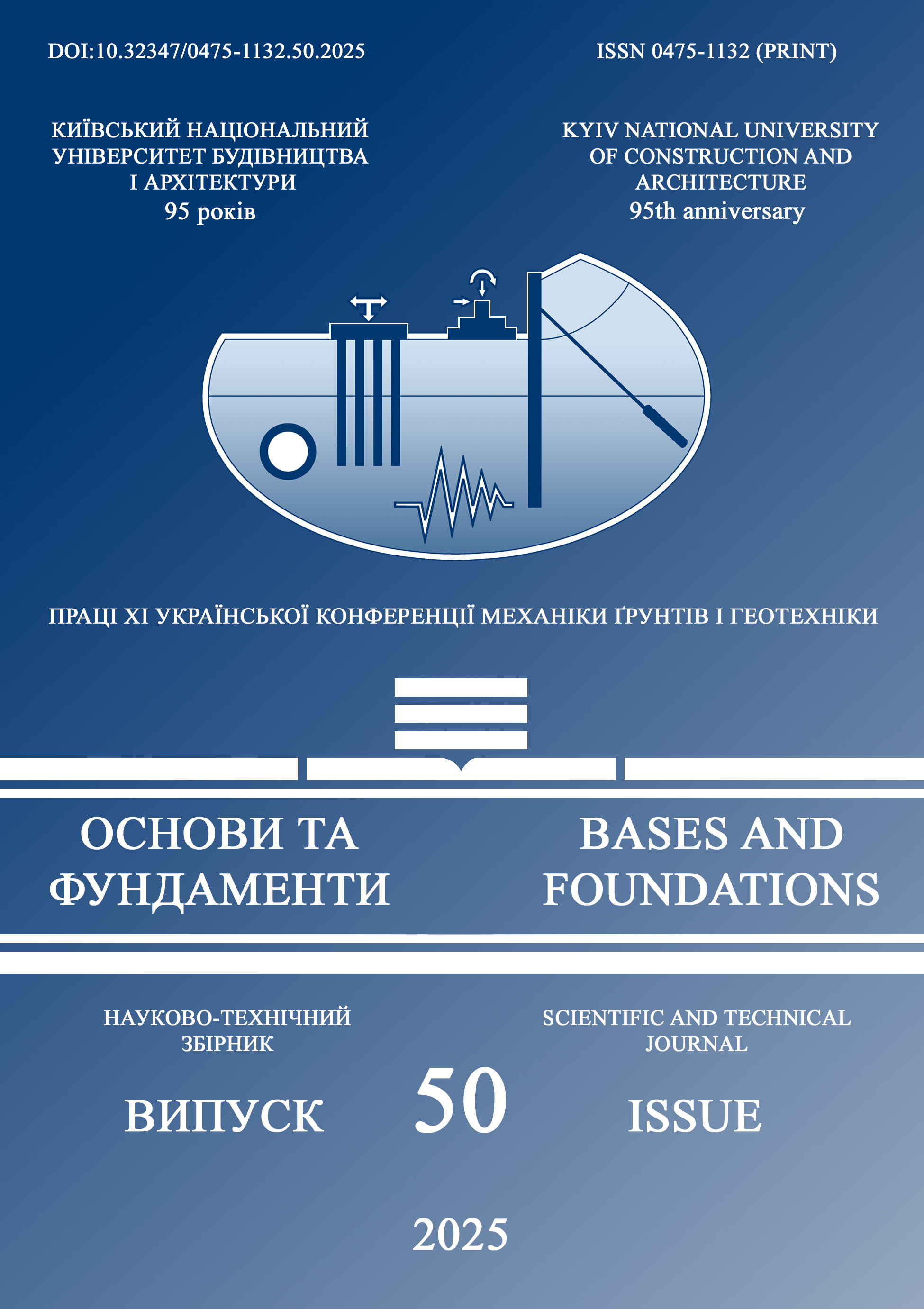Особливості взаємодії плитних фундаментів значних розмірів з ґрунтовою основою
Основний зміст сторінки статті
Анотація
В даний час актуальним напрямом досліджень в області геотехніки є відновлення та проектування енергетичних об`єктів, які в Україні будували часто на плитних фундаментах (АЕС, ТЕС та інші) Влаштування плитних фундаментів, які мають великі розміри в плані, що зумовлює особливості взаємодії їх з основою. На таких об`єктах проводився великий об`єм експериментальних робіт, на цих результатах і побудова ця публікація. З метою збереження експериментальних даних та виявлених нових факторів взаємодії плит з основою, а саме підйом дна котловану, при забивці паль на будівельному майданчику, за допомогою глибинних марок виявлена стислива зона, яка суттєво відрізняється від реальної (12 м практично проти 28 м розрахована за коефіцієнтами ДБН).
Окремо досліджувалися дилатансійні процеси, які зумовили підйом окремих паль до 30 см, що вимагало з`ясування обставин, що знаходяться під підошвою забитих паль і яку роль в формуванні осідання плитного фундаменту це відіграє.
Аналіз напружено-деформованого стану елементів конструкцій кожної будівлі (споруди) завжди треба виявити реальну активну зону деформації. В публікації приведені матеріали аналізу напружено-деформованого стану основи в залежності від розмірів плитних фундаментів, темп прикладання корисного навантаження (на прикладі силосних корпусів). Проведено порівняння глибини стисливої зони під плитою за методом пошарового підсумування (коефіцієнт з ДБН) і фактичною Hст, яка визначалася глибинними марками які були встановлені до глибини 28 м. Після прикладання проектного навантаження, глибинні марки на глибині більше 12 м не реагували.
Показана різниця в взаємодії великорозмірних плит з основою, а також розглянуто варіант при наявності коротких паль, які покращують властивості основи, але не виконують функції передачі напруження на більш глибинні шари ґрунтів.
Наведено приклад підйому котловану, для фундаментних плит АЕС (розміром 70х70 м), з варіантом забивних паль довжина 14,0м перерізом 35х35 см. При виконанні робіт виник підйом дна котловану більше ніж 50 см., а палі виходили за межі підйому на 30 см. Цей факт зумовив додаткові експериментальні роботи для з`ясування, для перевірки наявності під підошвою пустоти
З метою популяризації експериментальних даних і збереження досвіду проектування відповідальних об`єктів на плитних фундаментах великих розмірів і підготовлена ця публікація.
Блок інформації про статтю

Ця робота ліцензується відповідно до Creative Commons Attribution 4.0 International License.
Автори, які публікуються у цьому журналі, погоджуються з наступними умовами: Автори залишають за собою право на авторство своєї роботи та передають журналу право першої публікації цієї роботи на умовах ліцензії Creative Commons Attribution License, котра дозволяє іншим особам вільно розповсюджувати опубліковану роботу з обов'язковим посиланням на авторів оригінальної роботи та першу публікацію роботи у цьому журналі. Автори мають право укладати самостійні додаткові угоди щодо неексклюзивного розповсюдження роботи у тому вигляді, в якому вона була опублікована цим журналом (наприклад, розміщувати роботу в електронному сховищі установи або публікувати у складі монографії), за умови збереження посилання на першу публікацію роботи у цьому журналі. Політика журналу дозволяє і заохочує розміщення авторами в мережі Інтернет (наприклад, у сховищах установ або на особистих веб-сайтах) рукопису роботи, як до подання цього рукопису до редакції, так і під час його редакційного опрацювання, оскільки це сприяє виникненню продуктивної наукової дискусії та позитивно позначається на оперативності та динаміці цитування опублікованої роботи (див. The Effect of Open Access).Посилання
Бойко И.П. (1988) Свайные фундаменты на нелинейно-деформируемом основании (Дис. ... д-ра техн. наук). НИИОСП. Моск-ва.
Бойко І.П., Скочко (Бондарева) Л.О., & Хоронжевський. М. В. (2021) Ідентифіка-ція параметрів ґрунту на основі натурних випробувань паль. Основи та фундамен-ти: Науково-технічний збірник, 42. С. 9-18. DOI: 10.32347/0475-1132.42.2021.9-18.
Експлуатація технологічного комплексу. Моніторинг будівельних конструкцій АЕС. Загальні вимоги: СОУ НАЕК 109:2023. (2023). Державне підприємство «Національна атомна енергогенеруюча компанія «Енергоатом».
Bоyko I.P. (1988). Svajnye fundamenty na nelinejno-deformiruemom osnovanii [Pile foundations on a non-linearly deformable base]. Dys. doktora tekhn. nauk. NIIOSP. Moscow. (in Russian).
Boyko I.P, Skochko (Bondareva) L.O, & Khoronzhevskyi M.V (2021). Identifikatsia parametriv gryntiv na osnovi rezyltativ natyrnih vuprobyvan pal [Identification of soil parameters based on the results of field tests of piles]. Osnovu ta fundamenty: Naukovo-tekhnichnyj zbirnyk, 42, 9-18 (in Ukrainian). DOI: 10.32347/0475-1132.42.2021.9-18.
Ekspluatatsiya tekhnolohichnoho kompleksu. Monitorynh budivelʹnykh konstruktsiy AES. Zahalʹni vymohy: [Opera-tion of the technological complex. Monitor-ing of NPP building structures. General re-quirements] SOU NAEK 109:2023. (2023). Derzhavne pidpryyemstvo «Natsionalʹna atomna enerhoheneruyucha kompaniya «Enerhoatom». (in Ukrainian).
